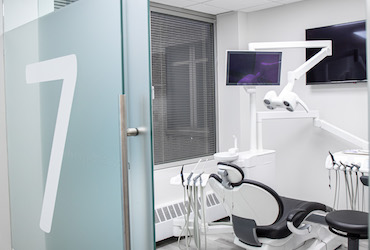What are veneers? Veneers at 65 Broadway Dental are a popular option for those looking to enhance their smile. Book your appointment and have you veneers done at 65 Broadway Dental
Dental veneers are thin, tooth-colored shells that are attached to the front surface of teeth to improve their appearance. They’re often made from porcelain or resin-composite materials and are permanently bonded to your teeth.
Veneers can be used to treat a number of different cosmetic concerns, including chipped, broken, discolored, or smaller-than-average teeth.
Some people may only get one veneer in the case of a broken or chipped tooth, but many get between six to eight veneers in order to create an even, symmetrical smile. The top front eight teeth are the most commonly applied veneers.
What are the different types of veneers at 65 Broadway Dental?
Dental veneers are most commonly made out of porcelain or composite resin and require intensive prep work. But there are also “no-prep” veneers, which are applied through a different process.
Applying traditional dental veneers typically involves grinding down the tooth structure, sometimes removing some of the tooth — even past the enamel. This allows for proper placement, but it’s also an irreversible procedure that can be painful to go through and often requires a local anesthetic.
Porcelain veneers
Some dentists will begin by grinding down the teeth and then making an impression of your teeth for the creation of a mold. Then they’ll send the mold out to a lab for the porcelain veneer to be made.
Once the veneer is ready, your dentist can place it on your prepared tooth and cement it in place. Temporary veneers may be used until the permanent veneers come back from the lab.
Meanwhile, other dentists may use CAD/CAM technology so a computer can design the veneer. Your dentist can make the actual veneer right there in the office.
Composite resin veneers
If you choose composite resin veneers, your dentist will etch the surface of your tooth before applying a thin layer of the composite material to your prepared tooth.
Additional layers of composite may be necessary to achieve your intended look. Your dentist will finish by curing, or hardening, the composite veneer with a special light.
No-prep veneers
These include options like Lumineers and Vivaneers, which are specific brands of porcelain veneers. They take less time and are less invasive to apply.
Instead of removing layers of tooth under the enamel, no-prep veneers only affect the enamel. In many cases, no-prep veneers don’t require local anesthetics or temporary veneers.

Veneers: Before and after
You may be surprised by how much of a difference a dental veneer can make, taking you from a chipped, cracked, misshapen, or stained tooth to an evenly shaped, naturally colored tooth. Check out this set of before-and-after photos to see what you can expect.
What are the benefits of dental veneers?
The biggest benefit to veneers is improving the appearance of your teeth, giving you a brighter and more even smile. Dental veneers are often used to treat the following cosmetic occurrences:
- broken or chipped teeth
- severe discoloration or uneven coloring that can’t be fixed with whitening
- gaps in the teeth
- smaller-than-average teeth
- pointed or unusually shaped teeth
Veneers can last for more than a decade, depending on the type of veneer you choose, making them a semipermanent investment that can make you more confident in your smile.

How to prepare for your appointment
Before you get your veneers, you’ll have a preliminary appointment with your dentist to discuss which options are right for you and how many veneers you want to have placed. In some cases, if teeth are crooked or uneven, you may need to have braces before your dentist can place the veneers.
Your dentist will often take X-rays at this stage to evaluate the health of your teeth. They’ll look for signs of tooth decay, gum disease, or the need for root canals. If you have any of these conditions, you may not be a candidate for veneers.
To get accurate sizing for your veneers, at the next appointment, your dentist trims down about half of a millimeter of your tooth (they remove the enamel using a grinding tool) before they take a mold (impression) of your teeth. This mold is then sent off to the lab to create your veneers.

How are veneers put on teeth?
It typically takes between 1 and 2 weeks after your dentist creates your mold to get your veneers back from the lab.
Once your veneers are in, you can schedule an appointment to have them placed. At this appointment, your dentist evaluates the fit, shape, and coloration of the veneers to make sure they’re perfect for you.
Next, your dentist thoroughly cleans your teeth. This is important, as it keeps bacteria from being trapped under the veneer and causing decay.
After they do this, they use the grinding tool to create a rougher texture on each tooth on which a veneer is to be applied. This makes it easier for the veneer to stick to the tooth.
Your dentist then uses dental cement to bond the veneer to the tooth. They’ll use ultraviolet light to harden this cement quickly.
This second appointment (where veneers are placed) typically doesn’t last longer than 2 hours. But it might vary depending on the number of veneers being done and if a local anesthetic is used.


